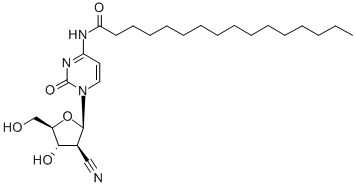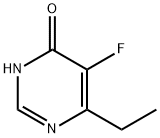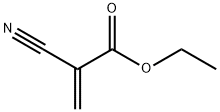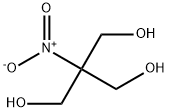Sapacitabine
Synonym(s):CS 682;CYC 682;N-[1-(2-Cyano-2-deoxy-β-D-arabinofuranosyl)-1,2-dihydro-2-oxo-4-pyrimidinyl]hexadecanamide
- CAS NO.:151823-14-2
- Empirical Formula: C26H42N4O5
- Molecular Weight: 490.64
- MDL number: MFCD00919466
- SAFETY DATA SHEET (SDS)
- Update Date: 2023-05-18 11:31:13

What is Sapacitabine?
The Uses of Sapacitabine
Sapacitabine, it is an orally available nucleoside analog prodrug of CNDAC that acts through a dual mechanism. It has potential use in chemotherapy.
Definition
ChEBI: Sapacitabine is a nucleoside analogue resulting from the formal condensation of the carboxy group of hexadecanoic acid with the amino group of CNDAC. It is the prodrug of CNDAC and is currently in clinical development for the treatment of acute myeloid leukemia (AML). It has a role as an antimetabolite, an antineoplastic agent, a prodrug and a DNA synthesis inhibitor. It is a nucleoside analogue, a nitrile and a secondary carboxamide. It is functionally related to a hexadecanoic acid and a CNDAC.
Biochem/physiol Actions
Sapacitabine is an orally active prodrug of nucleoside analog CNDAC that exhibits potent anti-tumor activity in both blood and solid tumors. CNDAC incorporates into DNA where it causes single-strand breaks (SSBs), which are converted into double strand breaks (DSBs) during S phase.
Properties of Sapacitabine
| Melting point: | >177°C (dec.) |
| Density | 1.21±0.1 g/cm3(Predicted) |
| storage temp. | -20°C Freezer, Under inert atmosphere |
| solubility | DMSO (Slightly), Methanol (Slightly, Heated) |
| form | Solid |
| pka | 10.04±0.20(Predicted) |
| color | White to Off-White |
Safety information for Sapacitabine
| Signal word | Warning |
| Pictogram(s) |
 Exclamation Mark Irritant GHS07 |
| GHS Hazard Statements |
H302:Acute toxicity,oral H315:Skin corrosion/irritation H319:Serious eye damage/eye irritation H335:Specific target organ toxicity, single exposure;Respiratory tract irritation |
| Precautionary Statement Codes |
P261:Avoid breathing dust/fume/gas/mist/vapours/spray. P305+P351+P338:IF IN EYES: Rinse cautiously with water for several minutes. Remove contact lenses, if present and easy to do. Continuerinsing. |
Computed Descriptors for Sapacitabine
New Products
4-AMINO-TETRAHYDRO-PYRAN-4-CARBOXYLIC ACID HCL 4-(Dimethylamino)tetrahydro-2H-pyran-4-carbonitrile 4-Aminotetrahydropyran-4-carbonitrile Hydrochloride (R)-3-Aminobutanenitrile Hydrochloride 3-((Dimethylamino)methyl)-5-methylhexan-2-one oxalate 1,4-Dioxa-8-azaspiro[4.5]decane 5-Bromo-2-nitropyridine Nimesulide BP Aceclofenac IP/BP/EP Diclofenac Sodium IP/BP/EP/USP Mefenamic Acid IP/BP/EP/USP Ornidazole IP Diclofenac Potassium THOMAIND PAPER PH 2.0 TO 4.5 1 BOX BUFFER CAPSULE PH 9.2 - 10 CAP SODIUM CHLORIDE 0.1N CVS ALLOXAN MONOHYDRATE 98% PLATINUM 0.5% ON 3 MM ALUMINA PELLETS (TYPE 73) LITHIUM AAS SOLUTION 2-Bromo-1-(bromomethyl)-3-chloro-5-nitrobenzene 2-Bromo-3-nitroaniline N-(3-Hydroxypropyl)-N-methylacetamide 3-Bromo-6-chloropyridazine 4-ethyl-3-nitrobenzoic acidRelated products of tetrahydrofuran








You may like
-
 Sapacitabine CAS 151823-14-2View Details
Sapacitabine CAS 151823-14-2View Details
151823-14-2 -
 1-Methyl-6-oxo-1,6-dihydropyridazine-3-carbonitrile 98%View Details
1-Methyl-6-oxo-1,6-dihydropyridazine-3-carbonitrile 98%View Details
99903-60-3 -
 1823368-42-8 98%View Details
1823368-42-8 98%View Details
1823368-42-8 -
 2-(3-(tert-butyl)phenoxy)-2-methylpropanoic acid 1307449-08-6 98%View Details
2-(3-(tert-butyl)phenoxy)-2-methylpropanoic acid 1307449-08-6 98%View Details
1307449-08-6 -
 Ethyl 3-(furan-2-yl)-3-hydroxypropanoate 25408-95-1 98%View Details
Ethyl 3-(furan-2-yl)-3-hydroxypropanoate 25408-95-1 98%View Details
25408-95-1 -
 2-Chloro-5-fluoro-1-methoxy-3-methylbenzene 98%View Details
2-Chloro-5-fluoro-1-methoxy-3-methylbenzene 98%View Details
1805639-70-6 -
 1784294-80-9 98%View Details
1784294-80-9 98%View Details
1784294-80-9 -
 Lithium ClavulanateView Details
Lithium ClavulanateView Details
61177-44-4